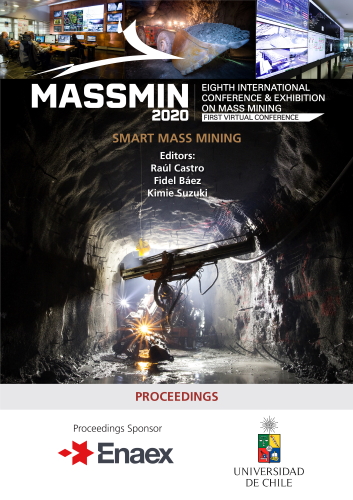Calibration of structurally controlled caving propagation using 3DEC. The Esmeralda Block 1 case study

|
Authors: Álvarez, C; Gómez, P; Orrego, C; López, S |
This paper is hosted with the kind permission of Lulea University of Technology, International Conference & Exhibition on Mass Mining, 2024.
DOI https://doi.org/10.36487/ACG_repo/2063_27
Cite As:
Álvarez, C, Gómez, P, Orrego, C & López, S 2020, 'Calibration of structurally controlled caving propagation using 3DEC. The Esmeralda Block 1 case study', in R Castro, F Báez & K Suzuki (eds), MassMin 2020: Proceedings of the Eighth International Conference & Exhibition on Mass Mining, University of Chile, Santiago, pp. 418-427, https://doi.org/10.36487/ACG_repo/2063_27
Abstract:
In the context of the transition studies from Open Pit to Block Cave mining at the Chuquicamata Underground Project, the validation of Itasca´s caving algorithm being used to predict caveability in a structurally controlled environment was deemed necessary. CODELCO proposed application of the caving algorithm to the observed caving behavior of Block 1 case study at Esmeralda Mine, El Teniente Division, which was known to have been influenced by the presence of a few major faults in its development. This paper presents the first successful attempt to calibrate a structurally controlled caving process in 3DEC.Itasca implemented the caving algorithm in 3DEC using all the data provided by CODELCO and successfully matched the observed behavior at El Teniente´s Esmeralda mine. From the calibration, it was concluded that the parameters with the most significant influence in the results were the stress field, rock mass properties and faults properties. A good correlation was obtained when compared with the emerging cave shapes from the model and the position of the micro-seismic activity recorded in the period of interest. When comparing the results of the geometric observational modeling developed by CODELCO with the emerging results from the 3DEC model, a reasonable match was observed in terms of geometry and volume of the caves. Additionally, breakthrough to the upper level Teniente 5 and the main propagation mechanism influenced mainly by J and H Faults were captured.
References:
Duplancic, P & Brady,BH 1999, ‘Characterization of Caving Mechanisms by Analysis of Seismicity and Rock Stress’, in Proceedings, 9th ISRM Congress on Rock Mechanics, Paris, France, G Vouille & P Bérest, Eds. Rotterdam: Balkema, vol. 2, pp. 1149-1053.
Hoek, E & Diederichs, MS 2006, ‘Empirical Estimation of Rock Mass Modulus’, International Journal of Rock Mechanics and Mining Sciences, vol. 43, pp. 203-215.
Hoek, E, Carranza-Torres, C & Corkum, B 2002, ‘Hoek-Brown Failure Criterion - 2002 Edition’, in NARMS-TAC 2002: Mining and Tunnelling Innovation and Opportunity, R Hammah et al., Eds. Toronto: University of Toronto Press, vol. 1, pp. 267-273.
Itasca Consulting Group, Inc. 2019, ‘FLAC3D (Fast Lagrangian Analysis of Continua in 3 Dimensions)’, Version 7.0. Minneapolis: Itasca.
Itasca Consulting Group, Inc. 2013, ‘3DEC — Three-Dimensional Distinct Element Code’, Ver. 5.0. Minneapolis: Itasca.
Lorig, L & Pierce, M 2000, ‘Methodology and Guidelines for Numerical Modelling of Undercut and Extraction-Level Behaviour in Caving Mines’, Itasca Consulting Group, Inc., Report to the International Caving Study, ICG00-099-6-15F, October 2000.
Millán, J & Brzovic, A 2014, “Review of Physical-Mechanical Properties for intact rock and El Teniente faults”, Internal Report . GRMD-SGL-INF-081-2014, Rancagua, Chile, in Spanish.
Millán, J & Brzovic, A 2013a, ‘Geological - Structural Analysis at the beginning and propagation of the caving in Block I, Esmeralda Mine’, Internal Report CODELCO GRMD-SGL-INF-083-2013, Rancagua, Chile, in Spanish.
Millán, J & Brzovic, A 2013b, ‘Cave modelling and material flow estimation in Block I, Esmeralda mine, El Teniente deposit’, Geomin 2013, Santiago, Chile.
Pierce, M, Cundall, P, Darcel, C, Min, KB, Potyondy, D, Young, P, Reyes-Montes, J & Pettitt, W 2006, ‘Six Monthly Technical Report: Caving Mechanics, Sub-Project No. 4.2 (Research and Methodology Improvement) & Sub-Project No. 4.3 (Case Study Application)’, Itasca Consulting Group, Inc., Report to Mass Mining Technology Project, Sustainable Mineral Institute (SMI), University of Queensland (Australia), ICG05-2292-1-Task2-33, September.
Quiroz, R, Vega, H, Cuello, D, Cifuentes, C, Quezada, O, Millán, J & Barraza, M 2010, ‘South Esmeralda definitions of growth’, Internal Report Interno DPL-I-2010, in Spanish.
Sainsbury, DP, Sainsbury, BL, Board, MP & Lorig, L 2011, ‘Numerical Back-Analysis of Structurally Controlled Cave Initiation and Propagation at the Henderson Mine’, in ARMA 2011 (Proceedings, 45th US Rock Mechanics/Geomechanics Symposium held in San Francisco, Ca, June 26-29).
Sainsbury, DP, Sainsbury, BL & Lorig, LL 2010, ‘Investigation of Caving Induced Subsidence at the Abandoned Grace Mine’, in Caving 2010 (Proceedings, Second International Symposium on Block and Sublevel Caving, Perth, Australia, April 2010),
Y Potvin, Ed. Perth: Australian Centre for Geomechanics, pp. 189-204.
Sainsbury, B, Pierce, ME & Mas Ivars, D 2008, ‘Analysis of Caving Behaviour Using a Synthetic Rock Mass — Ubiquitous Joint Rock Mass Modelling Technique’, in SHIRMS 2008 (Proceedings, 1st Southern Hemisphere International Rock
Mechanics Symposium, Perth, Western Australia, September 2008), Y Potvin et al., Eds. Nedlands, Western Australia: Australian Centre for Geomechanics, vol. 1, pp. 343-252.
Vallejos, J, Suzuki, K, Brzovic & A, Mas Ivars, D 2014, ‘Characterization and synthetic simulations to determine rock mass behaviour at the El Teniente mine, Chile. Part II’, Caving 2014, Santiago, Chile.
© Copyright 2025, Australian Centre for Geomechanics (ACG), The University of Western Australia. All rights reserved.
View copyright/legal information
Please direct any queries or error reports to repository-acg@uwa.edu.au
View copyright/legal information
Please direct any queries or error reports to repository-acg@uwa.edu.au
